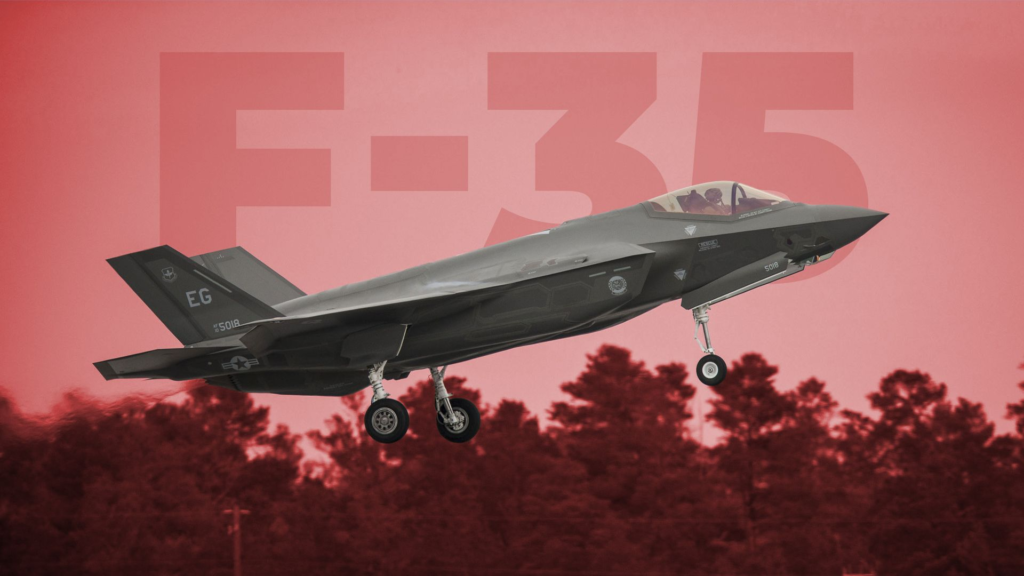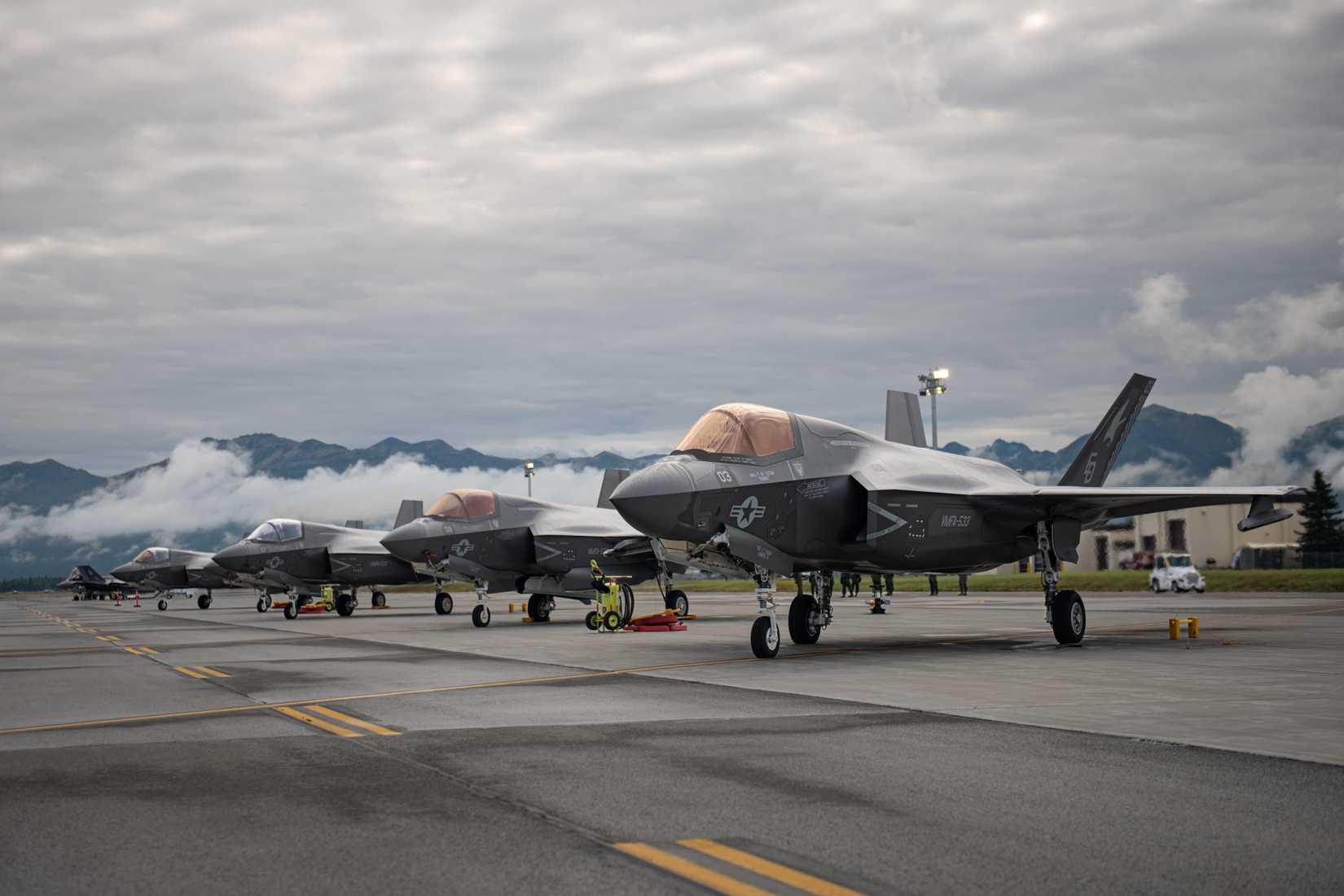At the end of September, the US Government’s F-35 Joint Program Office (JPO) finalized a $25 billion deal for up to 296 more fighter jets. The sum of money for lots 18 and 19 is staggering, yet the F-35 is one of the most affordable combat fighters and the least expensive fifth-generation, stealth platform by far.
The average price of an F-35 is currently tagged at $82 million thanks to the large-scale orders from the US Air Force, Navy, Marines, and partner nations under the original Joint Strike Fighter (JSF), and Foreign Military Sales (FMS) programs, according to Defense Express. For comparison, a new ![]() Boeing F-15EX Eagle costs $90 million on the low end and up to $97 million.
Boeing F-15EX Eagle costs $90 million on the low end and up to $97 million.
Lockheed Martin’s F-35 Lightning II is the manifestation of a decades-long effort to consolidate the different service branches, and allied air forces into a shared platform. The global fleet has reached more than 1,230 units in total thanks to a spectacular display of mass production. The rapid ramp-up in output has been hosted at the World War II-era “Bomber Plant” in Fort Worth, Texas, with its one-mile-long assembly line.
Affordable Stealth Technology
The primary difference in capability that sets the F-35 apart from its competitors is the fact that it is a stealth fighter. The F-15EX may out-climb, outrun, and carry more weapons, but on the battlefield of tomorrow, that means nothing if you can’t target your adversary. The F-22 Raptor was produced in much lower numbers than the F-35, sub-200 total, which ballooned its initial purchase price to over $150 million per plane. Since then, the lifetime cost of the world’s first fifth-gen stealth fighter has been estimated to total as much as $350 million for each F-22.
The F-35 has already changed that formula thanks to a lean, efficient design that has an open-architecture, modular design for lifetime upgrades and simple sustainment. The JSF has far more easily upgraded software and hardware in its avionics to roll out fixes and upgrades to the global fleet rapidly. These are key areas that have driven up the cost of the F-22 and its larger bomber counterpart, the Northrop Grumman B-2 Spirit.
The price varies by variant and contract specifics, as Defense Express outlined in its analysis, with the $82 million figure representing the average cost between the three models. The F-35A is the least complex base model, while the F-35B is the most complex because of its central lift fan that enables it to perform vertical take-off and landings. The F-35C naval variant sits in the middle, as it has larger landing gear and wings than the F-35A.
Another good price comparison can be found in the fourth-gen Dassault Rafale that serves the French Armed Forces, which Defense Express estimates costs $131 million per plane. Then there’s the fourth-gen-plus Eurofighter Typhoon, which comes in around $117 million per fighter, according to Defense Media. That means the more capable F-35 is 30-40% less expensive than the fighters of the previous generation that are still in production.
Fat Amy’s Fan Club
A major factor in the conservative costs that have been invested in the massive F-35 program is the multinational and joint-service participation. The original JSF partners included the United States, the United Kingdom, Italy, the Netherlands, Canada, Denmark, Norway, Turkey, and Australia. Since then, even more have joined, which has helped keep the average price down by keeping the assembly line and supply chain spooled up to normal capacity.
If you’re familiar with the F-35, you may have heard its endearing nickname: “Fat Amy.” The moniker stems from its rotund fuselage that houses the immensely powerful Pratt & Whitney (P&W) F135 turbofan engine and its internal weapons bay. The slightly jeering informal name is par for the course, as with many military traditions, but the jet has been enthusiastically received by every air force of the 20 different nations that have ordered the F-35.
The global fleet is supported by an equally international production and sustainment supply chain. The different manufacturers that contribute to the program are spread out across the different countries participating, with the central line in Forth Worth, but additional final check-out lines in Cameri, Italy, and Nagoya, Japan. The growing number of customers promises to keep strengthening that worldwide network as more jets roll off the line every day.
42,000 Hours To Perfection
The estimated time required to complete an F-35 from day one on the assembly line to first flight has been calculated to be 42,000 labor hours, or nearly five years, as AMFG reported. Lockheed Martin describes the overall economic impact of the JSF program to be worth $72 billion a year. That sustains nearly 300,000 jobs, with the majority being based in the USA.
The number of suppliers around the world includes 1,650 different vendors. The lead contractor is Lockheed Martin of course, but BAE Systems and Northrop Grumman make the fuselage while Raytheon/RTX makes radar and weapons. Italy’s Leonardo makes the cockpit glass as well as avionics and sensors. Lockheed Martin also claims that 1,900 technology suppliers are encompassed by the umbrella of the F-35 program, with 1,000 of them being small business corporations.
A major social and economic value point from the scale of the F-35 program is the skills growth for American workers and the partner nations participating in the supply chain. Expanding the skilled workforce in fields like artificial intelligence, software development, and cybersecurity is critical to the US economy of the future.
Skunk Works At It Again
The full scope of the JSF’s development and production has achieved the status of the single most expensive defense project in US history, even surpassing the atomic bomb and Boeing B-29 Superfortress of WWII. The F-35 is a product of Lockheed Martin’s (LM) Skunk Works, which under the leadership of Kelly Johnson, developed some of the most iconic and revolutionary designs in not only American history, but all of aerospace engineering.
Starting with the P-38 Lightning, from which the F-35 derives its official name, Johnson designed one of the most successful fighters of WWII and the most mass-produced twin-boom, twin-engine propeller fighter in history, with 10,038 made. The legendary engineering team went on to make one of the first jet fighters in the post-war era, the P-80 Shooting Star, followed by one of the first supersonic fighters, the F-104 Starfighter. Skunk Works also made the U-2 Dragon Lady in the 1950s, which is still flying reconnaissance in the upper atmosphere today.
Then came the incredible SR-71 Blackbird in the 1960s that flew Mach 3.2 at 100,000 feet and remains one of the fastest manned aircraft ever made. Then the F-117 Nighthawk came in the 1990s, introducing the world to stealth fighters. Of course, the F-22 remains one of the crowning technological marvels of the star-studded portfolio, but the F-35 is a truly worthy successor to this incredible legacy.
The F-35 combines the stunning technology that remains unequaled by near-peers like Russia’s Su-57 Felon or China’s J-20 Mighty Dragon, with the value of mass production that hearkens back to the roots of Skunk Works’ founder and his first great design. Lockheed Martin as a corporation has grown to become a juggernaut of the defense industry, but the programs that crafted its identity are by far and large creations of this storied engineering house that embodies the highest ideals of American ingenuity and daring.
Built To Last
A crucial aspect of the JSF design that is meant to be a generational design improvement over the first stealth combat aircraft is the durability, ease of maintenance, and less costly nature of its materials and systems. The F-22 and B-2 have both suffered from significant maintenance costs and prohibitively expensive upgrade cycles to keep them relevant in the face of shifting defense technologies. The radar-absorbent material (RAM) that is painted on the preceding generation was a major issue that the F-35 is expected to address with far less overall maintenance and less cost, and time per depot visit.
Today, the F-22 remains the apex of air superiority fighters, the B-2 is still the only active service stealth bomber in the world, and even the F-117 has been brought out of retirement to aid with testing and training. These groundbreaking designs have stood the test of time thanks to exceptional engineering, although the price tag they came with has detracted from the overall defense budget. The F-35s lower operating cost will help the fleet stay at a high readiness level and free up more funds for other programs.
The latest Technology Refresh iteration, TR-3, has been delayed in its roll-out, but it is set to accompany 75 upgrades in the Block 4 modernization update that LM is set to release for all three variants of the F-35 in the upcoming months. The Lightning II continues to push the standards of air power higher with every new feature and performance enhancement.
Keeping the price tag low empowers the US and its allies to field an unrivaled shield of air defense. Sharing a common airframe across services and borders helps protect every nation in the global fleet. Joint defense at an affordable price is the strategic power of the F-35, keeping aggressors like Russia at bay, and checking the power of hegemons like China through superior air power and unified defense.












